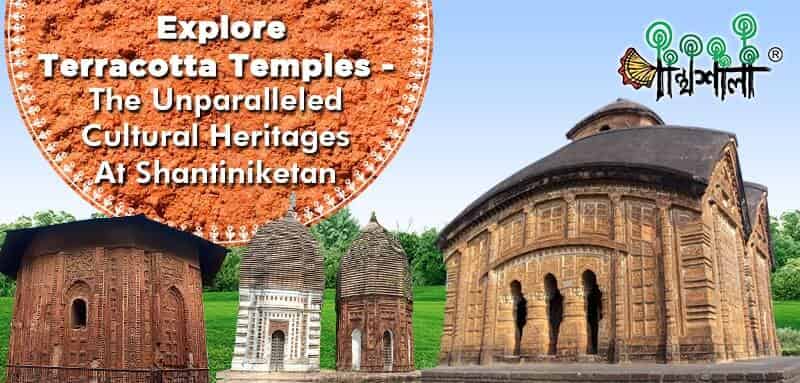The art of Terracotta is one of the oldest traditional art forms in Bengal that dates back to the Indus Valley civilisation. Indians mastered this art about 3000 years before the birth of Christ which was mainly expressed through the medium of temples. Due to the non-availability of stone, Bengali artists found expression in clay, which was abundantly available. Making objects with clay neither required any complex technical know-how nor heavy financial involvement. Clay objects were either baked in the sun or burnt into terracotta for hardening and durability that eventually became a popular medium of art expression of the people from the very dawn of civilisation in this deltaic land. Bengal artisans opted for terracotta tiles or plaques to decorate the walls of the temples, mosques and other places of worship and break the monotony of the dull, plain temple walls.
A coherent series of architecture and sculpture inspired by terracotta art is found in the temples of Bankura, Hooghly, and Burdwan districts and some places in Birbhum mostly all near Shantiniketan. Tourists mainly visit Shantiniketan for exploring Vishva Bharati University Campus along with its adjacent Sriniketan and Prakriti Bhawan, stroll along the Kopai River, listen to Baul songs or shop at local village outlets or ‘Sonajhurir Haat’. The marvellous terracotta temples are scattered nearby Shantiniketan, which are the most important manifestations of this region’s culture, religious movements, literature, art and broader political developments. Panthashala offers guest house near Visva Bharati from where you can easily set out to explore the brick temples with rare terracotta murals on their walls that are still being the witness of unique Bengali style of monumental architecture.
We have picked up 5 terracotta temples with interesting trivia that will lure you enough for paying a visit next time you are in Santiniketan:
1. Surul Boro Bari:

Situated 5km west of Surul, this is a residence come temple built in 1960 A.D. Surul Boro Bari is famous for its Durga Puja, started 250 years ago which is still celebrated with grandeur. The old-fashioned ‘Natmandir’ with round pillars surrounding it, is still carrying the aristocracy of the former Zamindars who are still preserving their tradition. There is Pancha Ratna Lakshmi Janardan Temple, adjacent to the Surul Rajbari where the story of Ramayana is expressed through intricate terracotta work.
2. Jora Bangla Kali Temple:

It is believed that about 200 years ago, Jora Bangla Kali Temple was housed by a band of robbers named as Hadkata group. The temple is a heritage property with exquisite terracotta panels that are a treat to watch. From naval gunfight to religious myths – all are beautifully sculpted here. The wall panels have Goddess Chandi sitting on lion fighting demons, young hanuman attacking the Chariot of Sun, Dasvatar and Dasamahavidya motifs that have been designed with extreme details. The floral design and vertical friezes also draw attention.
3. Jora Shiv Mandir:

Jora Shiv Temple at Supur flaunts beautiful terracotta art. There are open verandahs on all sides. The western side temple has only terracotta work on its Southern side while the eastern side octagonal temple has terracotta on all its eight sides. The terracotta panels displaying human figures, floral designs are impressive. The panel over the entrance shows Ram and Sita on a throne flanked by Rama’s court’s men while each of the lower sub-panel shows Chaitanya Maha Prabhu dancing with a bearded man beside him, a five-headed man dancing with others and a child (Probably Krishna) being bathed by four women. A small part of Satyajit Ray’s movie ‘Ashani Sanket’ was shot here.
4. Hath-tala MahaprabhuTemple:

Hath-tala Mahaprabhu Temple is located in Ilambazar where some of the finest terracotta work can be seen. Locals regularly visit there to worship Gaur Nitai, the deities inside Mahaprabhu temple. The upper arch panel of the door facing the road displays Maa Durga and her family in Chalchitra style where a wave pattern can be noticed. A huge Terracotta Lotus etched on the panel has miraculously survived the sufferings from the hands of fate. You can find the depiction of Brahma, Krishna, clay models of some women, a priest with a tilak on forehead, a man with a folded umbrella and so on – the detailed work of their expressions will amaze the Terracotta art lovers.
5. Chaarchala temple of Raghunathjee:
Dedicated to Lord Rama, Raghunathjee temple is located in Ghurisa village, near Illambazar which is about 30 km West of Bolpur Shantiniketan. The Char Chala temple is has been constructed on an elevated platform with an open verandah on four sides. It is said that once this temple housed a golden image of Rama which is looted by Maratha raiders in the 18th century. There are many mythical and floral engravings on the exterior walls of the temple. Motifs of Shiva riding on a bull, four-headed Brahma on his swan, Dasamahavidya Motifs, Dasavatar Motifs can be seen on the arch panels above the entrance and walls.
Summary:
Terracotta is one of the earliest forms of art in Bengal. The beautiful carvings on the walls of the terracotta temples in Birbhum are still carrying the legacy of great architecture and mythological tales that have a great historical significance.

